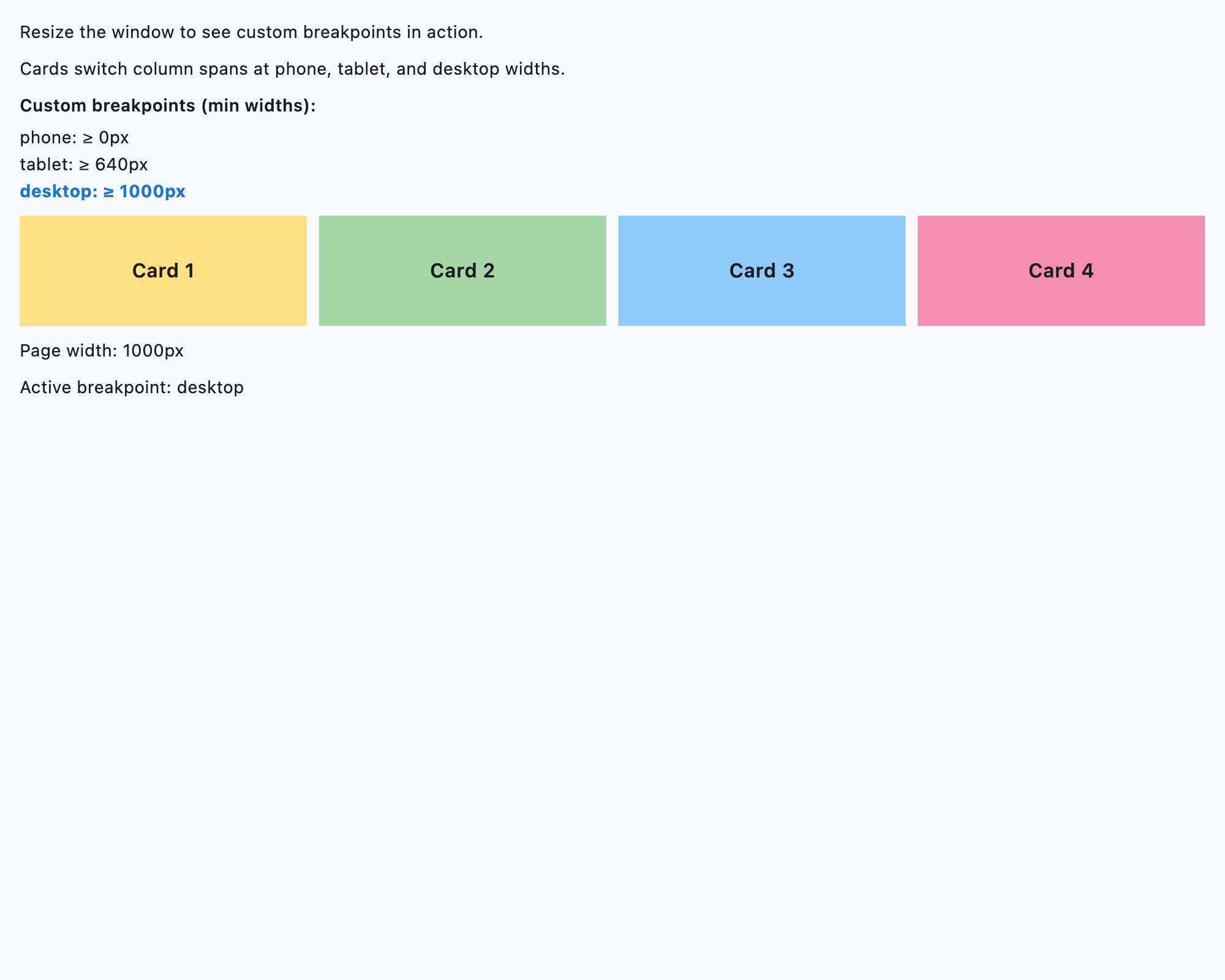ResponsiveRow
Responsive row
Inherits: LayoutControl, AdaptiveControl
Properties
-
alignment(MainAxisAlignment) –Defines how the child
controlsshould be -
breakpoints(dict[str | ResponsiveRowBreakpoint, Number]) –Defines the minimum widths (in px) for each breakpoint key used by responsive
-
columns(ResponsiveNumber) –The number of virtual columns to layout children.
-
controls(list[Control]) –A list of Controls to display.
-
run_spacing(ResponsiveNumber) –The spacing between runs when row content is wrapped on multiple lines.
-
spacing(ResponsiveNumber) –The spacing between controls in a row in virtual pixels.
-
vertical_alignment(CrossAxisAlignment) –Defines how the child
controlsshould be placed
Methods
-
clean–
Examples#
ResponsiveRow#
import flet as ft
def main(page: ft.Page):
def handle_page_resize(e: ft.PageResizeEvent):
pw.value = f"{page.width} px"
pw.update()
page.update()
page.on_resize = handle_page_resize
pw = ft.Text(text_align=ft.TextAlign.END, style=ft.TextTheme.display_small)
# page.overlay.append(pw)
page.add(
ft.ResponsiveRow(
controls=[
ft.Container(
content=ft.Text("Column 1"),
padding=5,
bgcolor=ft.Colors.YELLOW,
col={
ft.ResponsiveRowBreakpoint.XS: 12,
ft.ResponsiveRowBreakpoint.MD: 6,
ft.ResponsiveRowBreakpoint.LG: 3,
},
),
ft.Container(
content=ft.Text("Column 2"),
padding=5,
bgcolor=ft.Colors.GREEN,
col={
ft.ResponsiveRowBreakpoint.XS: 12,
ft.ResponsiveRowBreakpoint.MD: 6,
ft.ResponsiveRowBreakpoint.LG: 3,
},
),
ft.Container(
content=ft.Text("Column 3"),
padding=5,
bgcolor=ft.Colors.BLUE,
col={
ft.ResponsiveRowBreakpoint.XS: 12,
ft.ResponsiveRowBreakpoint.MD: 6,
ft.ResponsiveRowBreakpoint.LG: 3,
},
),
ft.Container(
content=ft.Text("Column 4"),
padding=5,
bgcolor=ft.Colors.PINK_300,
col={
ft.ResponsiveRowBreakpoint.XS: 12,
ft.ResponsiveRowBreakpoint.MD: 6,
ft.ResponsiveRowBreakpoint.LG: 3,
},
),
],
),
ft.ResponsiveRow(
run_spacing={ft.ResponsiveRowBreakpoint.XS: 10},
controls=[
ft.TextField(
label="TextField 1",
col={ft.ResponsiveRowBreakpoint.MD: 4},
),
ft.TextField(
label="TextField 2",
col={ft.ResponsiveRowBreakpoint.MD: 4},
),
ft.TextField(
label="TextField 3",
col={ft.ResponsiveRowBreakpoint.MD: 4},
),
],
),
pw,
)
if __name__ == "__main__":
ft.run(main)
Custom breakpoints#
import flet as ft
def main(page: ft.Page):
page.title = "ResponsiveRow with custom breakpoints"
page.padding = 16
breakpoints = {
"phone": 0,
"tablet": 640,
"desktop": 1000,
}
sorted_breakpoints = sorted(breakpoints.items(), key=lambda item: item[1])
breakpoint_labels = {
name: ft.Text(f"{name}: \u2265 {value}px", weight=ft.FontWeight.W_500)
for name, value in sorted_breakpoints
}
width_label = ft.Text()
breakpoint_label = ft.Text()
def update_status(_=None):
width = (
(page.window.width if page.window and page.window.width else None)
or page.width
or 0
)
width_label.value = f"Page width: {width:.0f}px"
active_breakpoint = max(
(bp for bp, min_width in breakpoints.items() if width >= min_width),
key=lambda bp: breakpoints[bp],
default="phone",
)
breakpoint_label.value = f"Active breakpoint: {active_breakpoint}"
for name, label in breakpoint_labels.items():
is_active = name == active_breakpoint
label.color = ft.Colors.BLUE_700 if is_active else None
label.weight = ft.FontWeight.W_700 if is_active else ft.FontWeight.W_400
label.update()
width_label.update()
breakpoint_label.update()
page.on_resize = update_status
page.add(
ft.Text("Resize the window to see custom breakpoints in action."),
ft.Text("Cards switch column spans at phone, tablet, and desktop widths."),
ft.Column(
[
ft.Text(
"Custom breakpoints (min widths):",
weight=ft.FontWeight.W_600,
),
ft.Column(list(breakpoint_labels.values()), spacing=2),
],
spacing=6,
),
ft.ResponsiveRow(
breakpoints=breakpoints,
columns={"phone": 4, "tablet": 8, "desktop": 12},
spacing=10,
run_spacing=10,
controls=[
ft.Container(
content=ft.Text("Card 1", size=16, weight=ft.FontWeight.W_600),
alignment=ft.Alignment.CENTER,
bgcolor=ft.Colors.AMBER_200,
height=90,
col={"phone": 4, "tablet": 4, "desktop": 3},
),
ft.Container(
content=ft.Text("Card 2", size=16, weight=ft.FontWeight.W_600),
alignment=ft.Alignment.CENTER,
bgcolor=ft.Colors.GREEN_200,
height=90,
col={"phone": 4, "tablet": 4, "desktop": 3},
),
ft.Container(
content=ft.Text("Card 3", size=16, weight=ft.FontWeight.W_600),
alignment=ft.Alignment.CENTER,
bgcolor=ft.Colors.BLUE_200,
height=90,
col={"phone": 4, "tablet": 4, "desktop": 3},
),
ft.Container(
content=ft.Text("Card 4", size=16, weight=ft.FontWeight.W_600),
alignment=ft.Alignment.CENTER,
bgcolor=ft.Colors.PINK_200,
height=90,
col={"phone": 4, "tablet": 4, "desktop": 3},
),
],
),
width_label,
breakpoint_label,
)
update_status()
if __name__ == "__main__":
ft.run(main)
Properties#
class-attribute
instance-attribute
#
alignment: MainAxisAlignment = START
Defines how the child controls should be
placed horizontally.
class-attribute
instance-attribute
#
breakpoints: dict[str | ResponsiveRowBreakpoint, Number] = (
field(
default_factory=lambda: {
XS: 0,
SM: 576,
MD: 768,
LG: 992,
XL: 1200,
XXL: 1400,
}
)
)
Defines the minimum widths (in px) for each breakpoint key used by responsive
properties such as col, spacing,
and run_spacing.
Keys can be ResponsiveRowBreakpoint values or custom strings.
Breakpoint names in responsive values must match the names used here.
The default mirrors Bootstrap breakpoints.
class-attribute
instance-attribute
#
columns: ResponsiveNumber = 12
The number of virtual columns to layout children.
class-attribute
instance-attribute
#
A list of Controls to display.
class-attribute
instance-attribute
#
run_spacing: ResponsiveNumber = 10
The spacing between runs when row content is wrapped on multiple lines.
class-attribute
instance-attribute
#
spacing: ResponsiveNumber = 10
The spacing between controls in a row in virtual pixels.
Note
Has effect only when alignment is set to
MainAxisAlignment.START, MainAxisAlignment.END,
or MainAxisAlignment.CENTER.
class-attribute
instance-attribute
#
vertical_alignment: CrossAxisAlignment = START
Defines how the child controls should be placed
vertically.


